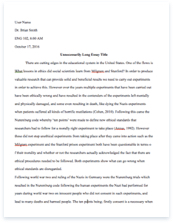Jane Eyre’s character

A limited time offer! Get a custom sample essay written according to your requirements urgent 3h delivery guaranteed
Order NowJane is a ten-year-old orphan whose parents died when she was only one year old. She is physically inferior to most people and has a plain countenance; these characteristics influence her personality and her behaviour towards people very strongly. Jane is not a pretty girl, and believes that this is the reason she is unloved. Mrs Reed tells Jane that she is ‘less than a servant’, so she develops wittiness and a strong spirit to be noticed and praised.
For nine years, she has lived with her unloving Aunt Reed, and her three terrible cousins: John, Eliza and Georgiana. John abuses her; he hits and bullies her continuously. Jane tolerates this for most of her life and then suddenly has an outburst at the age of ten, when she hits John, and finally sticks up for herself. She is punished for this action and locked up in the room where her uncle ‘breathed his last’.
Jane could be described as a lonely ‘Cinderella’ figure, primarily because she is excluded from the rest of the family. ‘Me, she had dispensed from joining the group; saying, “She regretted to be under the necessity of keeping me at a distance”.’ This shows that Mrs Reed treats Jane as an outcast and does not comfort or love her, and is obviously not sorry for keeping her at a distance.
Mrs Reed says that Jane could not join the family until she was to ‘acquire a more sociable and childlike disposition’, also that ‘she really must exclude me from privileges’. Jane describes herself as a ‘heterogeneous thing’, heterogeneous meaning nothing like the Reed family, and thing indicating that she is just an object as far as the Reeds’ were concerned, not a real person worth caring about.
Rebellion is quite a strong theme in the book, as Jane rebels against the Reeds’ many times in chapters one to four. Firstly, Jane hits John after he throws a book at her, which knocks her into the door and, as a result, Jane cuts her head badly. Then, when being carried up to the Red Room as a punishment, Jane ‘resisted all the way’. Jane is also cheeky to Mr Brocklehurst, and answers him back when he asks what she will do to avoid going to hell. She answers ‘I must keep in good health, and not die’.
Spirits are symbolised throughout the chapters, for example, when Jane looks in the mirror of the Red Room she sees what she thought to be ‘like one of the tiny phantoms, half fairy, half imp’. Jane might have seen this image for several reasons. The most likely reason for Jane seeing herself as this is that she picked up an imagination from all of the stories that Bessie had read to her of fantasy creatures ‘coming out of lone ferny dells in moors’. There are many symbolic explanations as well. The fact that she saw herself as not being human could be because Mrs Reed and her children didn’t treat her as a proper human being. Jane might not recognise herself in the mirror, she probably doesn’t even know herself.
Jane is a very intelligent child. I know this because she reads intellectually demanding books for her time and age. She compares John Reed to Nero and Caligula, mad and cruel Roman emperors. These are obviously people whom she has read about and understood the characters enough to make a comparison. Jane is plainly spoken and uses polysyllabic words, which uneducated children would not use. For example, she says that poor people are synonymous with degradation. This show that she is well spoken, because I did not know what this statement meant, until I researched it; and I am older than Jane was, and am educated in English.
In this book, Bronte conveys character by using first person narrative throughout; sometimes, the older Jane looks back and reviews her actions. ‘I had nothing to say to these words: they were not new to me: my very first recollections of existence included hints of the same kind. This reproach of my dependence had become a vague sing-song in my ear: very painful and crushing, but only half intelligible.’ Bronte also uses animal imagery to describe Jane, for example ‘You rat’, ‘Rat! Rat!’ and ‘Bad animal’. Jane’s moods are reflected through the weather, using pathetic fallacy. ‘The cold winter wind had brought with it clouds so sombre, and a rain so penetrating’, is a gloomy reflection of her mood.
In conclusion, I have found that Jane’s personality has led her to trouble and rebellion in the Reed’s household. Jane is a bright girl, with a vivid imagination but has become rebellious because she is abused, bullied and uncared for by a horrid family who broke a promise to look after her.










